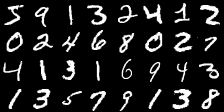The one macro which slices and dices, squeezes and splices!
It uses easy notation you already know from @tensor
and @einsum to express all kinds of reshaping and slicing of tensors, no matter how complicated!
There are three basic ways to use it, rotate the dial to := for a new object, = to use a pre-allocated one, and == for a view of the old:
@shape A[(i,j),k] := B[i,j,k] # new matrix from tensor B
@shape A[i,j,k] = B[(i,k),j] # write into an existing tensor A
@shape A[(i,j,k)] == B[i,j,k] # reshaped view A = vec(B)Slicing works the same way:
@shape A[i,j] := B[i][j] # hcat a vector of vectors
@shape A[i,j,k] = B[i,k][j] # write into tensor A
@shape A[i][j] == B[j,i] # create views A = collect(eachcol(B))You only need to name the output if you are writing into it, with =. You may also combine these basic operations:
A = @shape [(i,j)] := B[j][i] # vcat a vector of vectors
A = @shape [(i,j),l][k,m] := B[i][j,k,l,m] # glue then slice then reshapeReshaping where ranges of any indices are ambiguous will give an error.
You can provide explicit sizes by writing things like k:5 after the expression, either to avoid such ambiguities,
or simply to assert that sizes are as you expect.
For example, changing the second example above A[i,j,k] = B[(i,k),j] to use := instead
will leave the lengths of i and k unfixed (as they can no longer be read off from A),
unless we specify one of them:
B = rand(2*5, 3);
@shape A[i,j,k] := B[(i,k),j] i:2 # could give (i:2, j:3, k:5)
size(A) == (2,3,5)Since this is a dinky piece of plastic (costing well under $9.99) you should not be too surprised that, once the wrapping paper is thrown away, your computer ends up doing the actual work with exactly the same methods it would have used anyway. To see what's going on, we include (at no extra charge!) another macro which works like this:
@pretty @shape A[(i,j)] = B[i,j]
# copyto!(A, B)
@pretty @shape A[k][i,j] == B[i,(j,k)] k:length(C)
# begin
# local caterpillar = (size(B, 1), :, length(C)) # your animal may vary
# A = sliceview(reshape(B, (caterpillar...,)), (:, :, *))
# endThis is in fact just like the @macroexpand you already have, but shinier
(thanks to animal names from MacroTools.jl)
and less functional (deleting line number comments, and most module qualifiers).
Here TensorSlice.sliceview(D, (:,:,*)) = collect(eachslice(D, dims=3))
using the new eachcol & eachrow functions,
but allowing also things like sliceview(D, (:,*,:,*) ≈ eachslice(D, dims=(2,4)).
Moving on, here's a picture with a celebrity!
using TestImages, ImageView, FileIO
V = testimage.(["mandril_gray", "cameraman", "lena_gray_512"])
@shape M[i,(j,J)] := V[J][i,j]
imshow(M)
save("monkey-man-lena.jpeg", M)Or with one more dimension:
using Flux, ImageView, FileIO, JuliennedArrays
imgs = Flux.Data.MNIST.images()[1:32] # vector of matrices
@shape A[(i,I),(j,J)] := imgs[(I,J)][i,j] J:8 # eight columns
imshow(A)
save("famous-digits.png", A)Note that the order here (i,I) = (pixel, grid) is a choice made by this package,
such that A[(i,j),k] and B[i,j,k] have the same linear order A[:] == B[:],
and entries i and i+1 are neighbours because Julia Arrays are column-major.
The vector of matrices C[k][i,j] also has the same order, if the slices are StaticArrays, below.
Some of the work will be out-sourced to various clever packages if you load them.
First, JuliennedArrays.jl gives fast slices,
and is also able to re-assemble more complicated slices than something like reduce(cat,...) can handle.
There is no downside to this, perhaps it should be the default:
using JuliennedArrays
@shape S[i][j] == M[i,j] # S = julienne(M, (*,:)) creates views, S[i] == M[i,:]
@shape Z[i,j] := S[i][j] # Z = align(S, (*,:)) makes a copy
@shape A[i,j,k,l] := B[k,l][i,j] # error without JuliennedArraysSecond, StaticArrays.jl allows us to reinterpret a Matrix as a Vector of SVectors,
and so on, which is fast for small slices of fixed size.
This is only possible if the first indices of the array are the indices of the slice (such that they share a memory layout),
and if dimensions of the slice are known to the macro (by annotations like i:2, j:3 again).
By slight abuse of notation, such slices are written as curly brackets:
using StaticArrays
M = rand(Int, 2,3)
@shape S[k]{i} == M[i,k] i:2 # S = reinterpret(SVector{2,Int}, vec(M)) needs the 2
@shape N[k,i] == S[k]{i} # such slices can be reinterpreted back again
M[1,2]=42; N[2,1]==42 # all views of the original matrixIf they aren't literal integers, such sizes ought to be fixed by the types.
For example, this function is about 100x slower if not given the
value type Val(2):
cols(M::Matrix, ::Val{N}=Val(size(M,1))) where N = @shape A[j]{i} == M[i,j] i:N
@code_warntype cols(M, Val(2))Third, Strided.jl contains (among other things) faster methods for permuting dimensions,
especially for large arrays, as used by TensorOperations.jl.
Loading it will cause @shape to call these methods.
using Strided
A = rand(50,50,50,50);
B = permutedims(A, (4,3,2,1)); @strided permutedims(A, (4,3,2,1)); @strided permutedims!(B, A, (4,3,2,1)); # compile
@time C = permutedims(A, (4,3,2,1)); # 130 ms, 47 MB
@time @strided permutedims(A, (4,3,2,1)); # 0.02 ms, 400 bytes, lazy
@time @shape D[i,j,k,l] := A[l,k,j,i]; # 140 ms, 47 MB, copy
@time @shape E[i,j,k,l] == A[l,k,j,i]; # 0.02 ms, 256 bytes, view
@time @shape C[i,j,k,l] = A[l,k,j,i]; # 15 ms, 4 KB, in-placeThere is a slight potential for bugs here, in that @strided permutedims usually creates a view not a copy, and @shape knows this.
But this is true only for A::DenseArray, and on more exotic arrays it will fall back, in which case == may give a copy without warning
(as the macro cannot see the type of the array).
-
More torture-tests. They may still be bugs.
-
Perhaps there ought to be an operation in-between
:=which guarantees a copy, and==which guarantees a view, just do whatever is easiest. Abuse<<or<<=to mean this? Or abuse!=for guaranteeing a copy & free:=to mean whatever is easy? -
Slicing and gluing usually has sorted
code = (:,:,:,*,*)by default. Sometimes we could removepermutedimsby altering this, so far this happens only fortranspose, and only for slicing. (E.g.@pretty @shape A[(i,j)] := B[i][j]could be justvec(glue(B, (*, :))).) -
Now
@shape A[i]{j} = B[i,j] j:3is allowed, but in-place writing to (or replacing of) ordinary sub-arraysA[i][j]is not. -
Would be nice if
copyto!(A, glue(B, ...))could be just useglue!(A, B, ...).
Wishlist:
-
Support mutating operators
+=and*=etc. like Einsum.jl does. Should be fairly easy. -
Add reductions like
sum!(A,B)andsum(A, dims=...), maybe not so hard. -
Allow constant indices:
@shape A[i,j] := B[j,3,i] # allow constants
@shape A[i,j,$k] = B[j,i] # ... including k interpolated- Treat reverse, and shifts, in this notation:
@shape A[i,j] := B[i,-j] # reverse(B, dims=2)
@shape A[i,j] = B[i+1,j+3] # circshift!(A, B, (1,3))- A mullet as awesome as Rich DuLaney had.
Our minions are standing by for your call! For your convenience, they are located in another time zone (and are heavy users of google translate) so please open an issue if you have found a way to break your gadget. We guarantee a 100% refund... and double your money back if you open a pull request!
No need to wait for international shipping, just press the ] key:
pkg> add https://github.com/mcabbott/TensorSlice.jl
pkg> add StaticArrays JuliennedArrays Strided
julia> using TensorSlice
